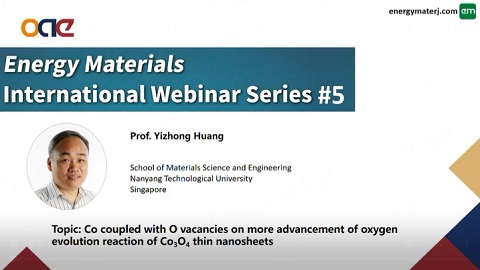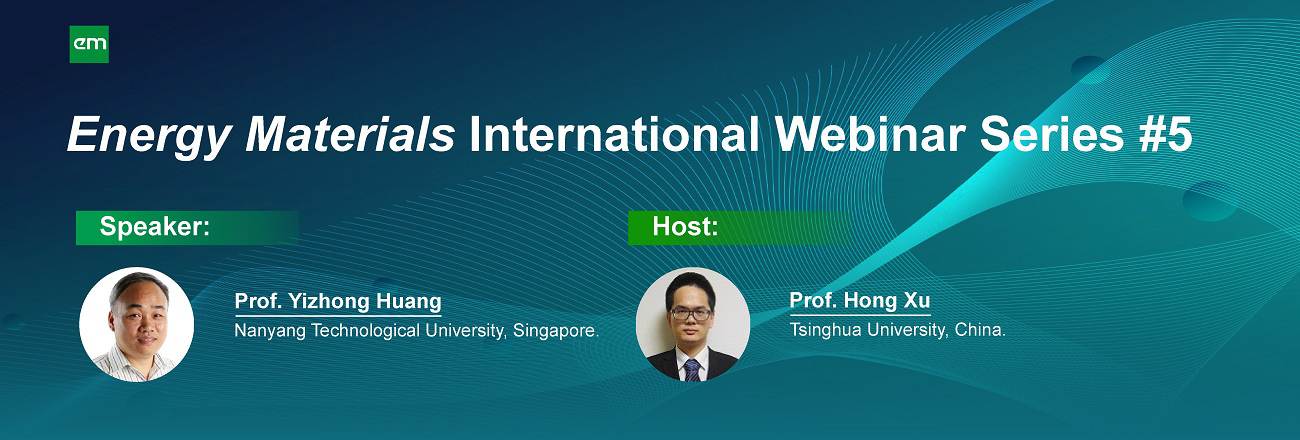Contents
Host

Prof. Hong Xu
Institute of Nuclear and New Energy Technology, Tsinghua University, Beijing, China.
Dr. Hong Xu is currently an associate professor in the Institute of Nuclear and New Energy Technology at Tsinghua University in China. He received his Ph.D. in structural molecular science at the Institute for Molecular Science, National Institutes of Natural Sciences (Japan) in 2015. After that, he worked as a postdoctoral researcher at Cornell University (USA). In 2018, he joined Tsinghua University as a faculty. His research interest lies in the fields of Lithium-ion Batteries, Porous Materials, Nanomaterials, and Quantum Chemistry. He has published 80 papers in journals such as Nature Chemistry, Nature Materials, Nature Communications, JACS, and Angewandte Chemie with a citation of 7600. He served as an associate editor of Energy Materials from 2022.
Dr. Hong Xu is currently an associate professor in the Institute of Nuclear and New Energy Technology at Tsinghua University in China. He received his Ph.D. in structural molecular science at the Institute for Molecular Science, National Institutes of Natural Sciences (Japan) in 2015. After that, he worked as a postdoctoral researcher at Cornell University (USA). In 2018, he joined Tsinghua University as a faculty. His research interest lies in the fields of Lithium-ion Batteries, Porous Materials, Nanomaterials, and Quantum Chemistry. He has published 80 papers in journals such as Nature Chemistry, Nature Materials, Nature Communications, JACS, and Angewandte Chemie with a citation of 7600. He served as an associate editor of Energy Materials from 2022.
Speaker
Prof. Yizhong Huang
School of Materials Science and Engineering, Nanyang Technological University, Singapore, Singapore.
Topic: Co coupled with O vacancies on more advancement of oxygen evolution reaction of Co3O4 thin nanosheets
Professor Yizhong Huang is currently positioned in School of Materials Science and Engineering at Nanyang Technological University in Singapore. He has been working in University of Oxford as a postdoc, research fellow (faculty member), college fellow of Wolfson and an academic visitor. He has been granted a few awards such as UK-Southeast Asia Partners in Science Collaboration Development. He has published over two hundred and sixty papers in journals such as Nature communications, Nano Letters, Advanced Materials and ACS Nano with a citation up to 10800 and an Hindex of 52. He has developed his expertise in transmission electron microscopy (TEM) and focused ion beam (FIB) system with specific research interests in nano-electrochemistry and hybrid nanostructured materials for energy applications. He has established and leads a strong academic group with 15 researchers including postdoctoral research fellows.
Abstract: Atomic vacancy has been demonstrated to generate new energy states in the bandgap whereby providing more active sites in many electrocatalytic processes. In this talk, development of a novel process to yield both Co and O vacancies in the synthetical Co3O4 nanosheets when subjected toa laser beam, will be introduced. The method, capable of creating both Co and O vacancies and embarking upon the prediction of the number of vacancies generated, is more reliable/controllable over other methods. The coupling of two types of vacancies eases the occurrence of Co3O4 oxidation reaction at a very low overpotential, which then facilities the OER at an over-potential of 290 mV with a small Tafel slope of 76 mV dec−1, much better than the pristine Co3O4 and the benchmark RuO2. DFT calculations suggest that the induced multi- vacancies create trap state in the bandgap of Co3O4 promoting the adsorption capability and advancing the water splitting.
Topic: Co coupled with O vacancies on more advancement of oxygen evolution reaction of Co3O4 thin nanosheets
Professor Yizhong Huang is currently positioned in School of Materials Science and Engineering at Nanyang Technological University in Singapore. He has been working in University of Oxford as a postdoc, research fellow (faculty member), college fellow of Wolfson and an academic visitor. He has been granted a few awards such as UK-Southeast Asia Partners in Science Collaboration Development. He has published over two hundred and sixty papers in journals such as Nature communications, Nano Letters, Advanced Materials and ACS Nano with a citation up to 10800 and an Hindex of 52. He has developed his expertise in transmission electron microscopy (TEM) and focused ion beam (FIB) system with specific research interests in nano-electrochemistry and hybrid nanostructured materials for energy applications. He has established and leads a strong academic group with 15 researchers including postdoctoral research fellows.
Abstract: Atomic vacancy has been demonstrated to generate new energy states in the bandgap whereby providing more active sites in many electrocatalytic processes. In this talk, development of a novel process to yield both Co and O vacancies in the synthetical Co3O4 nanosheets when subjected toa laser beam, will be introduced. The method, capable of creating both Co and O vacancies and embarking upon the prediction of the number of vacancies generated, is more reliable/controllable over other methods. The coupling of two types of vacancies eases the occurrence of Co3O4 oxidation reaction at a very low overpotential, which then facilities the OER at an over-potential of 290 mV with a small Tafel slope of 76 mV dec−1, much better than the pristine Co3O4 and the benchmark RuO2. DFT calculations suggest that the induced multi- vacancies create trap state in the bandgap of Co3O4 promoting the adsorption capability and advancing the water splitting.
Presentation

Prof. Yizhong Huang
Topic: Co coupled with O vacancies on more advancement of oxygen evolution reaction of Co3O4 thin nanosheets
NaN







